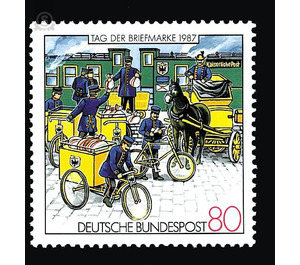day of the stamp - Germany / Federal Republic of Germany 1987 - 80 Pfennig
Theme: Post & Philately
| Country | Germany / Federal Republic of Germany |
| Issue Date | 1987 |
| Face Value | 80.00 |
| Color | multi-colored |
| Perforation | K 13 3/4 |
| Printing Type | Six-color offset printing |
| Stamp Type | Postage stamp |
| Item Type | Stamp |
| Chronological Issue Number | 1210 |
| Chronological Chapter | GER-BRD |
| SID | 770318 |
| In 46 Wishlists | |
Swiss Post has always used the latest technological advances to make its services faster and cheaper. In this way, it has promoted developments and brought about innovations through its own activities and plans. On the other hand, such innovations have often forced a departure from historically grown traffic structures. With the introduction of the railway, the post office lost z. For example, more and more of their hitherto paramount importance in the field of passenger transport, but was able to significantly expand their mail and parcel service in the wake of industrialization with skillful use of the opportunities thereby created. This development is evidenced by the presentation of a charge exchange in 1897, designed by the graphic designer in close accordance with a contemporary drawing by Ewald Thiel. Just now tricycles with removable box for transporting the letter bag from the station to the city post offices and the letterbox emptying were used. This innovation was initially not received without skepticism, because one - not without reason - doubted their Winter suitability. Apparently, the feared impairments were lower than expected, and the tricycles were not withdrawn. The bicycle shown in the center without box was used for telegram and express delivery. For transporting large loads, a one-pronged freight car is available, as was customary - according to a standard album of the »Imperial German Reichspost« - for the "transport of postal goods between the post offices and railway stations and to city post offices." The use of the railway for postal purposes began in 1839 on the route Berlin-Potsdam and was later extended to all newly added railroad lines. As early as 1841, our own "railway mail cars" were introduced, and as early as 1849 shipments could be processed while driving in "post office forwarding offices". From 1875, the post-office "railway mail cars" were referred to as "railway mail cars". The inscription "Imperial German Post" was introduced in 1871, but from 1881 only used in international traffic. In domestic traffic, they limited themselves to the sufficient and, moreover, cost-saving designation "Imperial Post." The occasion for this posthistorical presentation is the "Stamp Day" organized by the Bund Deutscher Philatelisten e.V. since 1975, with more than 1,500 clubs and youth groups organized by the umbrella organization of organized philately in the Federal Republic of Germany in various locations across the country. With exhibitions, advertising shows and collectors' meetings on the "Stamp Day" on October 25, 1987, the attraction and diversity of collecting stamps and post-historic documents will once again be brought to everyone's attention. At the same time, the tasks and services of the Association of German Philatelists e.V., its regional associations and the German Philatelist Youth for a total of around 90,000 registered members and a large number of close friends are brought to the public. (Text: Federal Postal Museum, Frankfurt am Main and Bund Deutscher Philatelisten e.V., Federal Office for Public Relations, Frankfurt am Main)


